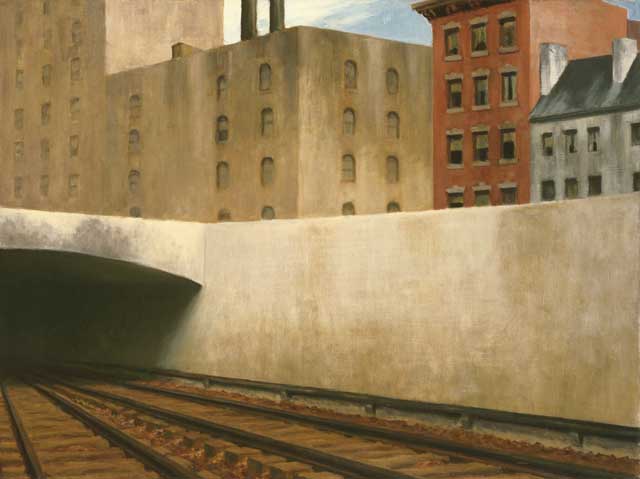Great Works: Approaching a City 1946 (70 x 80cm) Edward Hopper
The Phillips Collection, Washington, DC

Call it a ragged fragment torn off from that unreal city once evoked by T S Eliot. This sad, claustrophobic urban scene by Edward Hopper, with its flat, rearing tenement blocks, its long, blank-faced, featureless wall (which occupies about 30 per cent of the painting), and its eerily dark and beckoning tunnel entrance, looks like a problem without an answer. It does not raise our expectations. It does not propose any over-arching solution. It merely says: this is it. We must feel stolidly resigned to the nature of things as they are, as we have made them to be. There is nothing to do but take one step after another. Moody as the oppressive urban heat of a New York summer's day, the scene seems to be slipping back and back into an ever deeper haze of disappointed factuality even as we stare and stare into its stinking, misty shimmer.
No matter where we settle to looking – and our eye slowly travels back and forth across its surface, as if seeking some emotional point of entry, something that might enable us to say: yes, this is where its meaning begins – it never quite happens. It is a painting of psychological suspense and visual suspension. There is no sign of humanity in this painting, no face at a window, and yet everything that we see before our eyes – except for those fleeting snatches of blue sky, and they seem to be hurrying away – is relentlessly, pitilessly man-made, and none of it is pretty or delicate or elegant or beautiful or lightsome.
And there is so much of this man-made stuff in this painting. It feels as if Hopper has upended sackfuls of it in front of our very eyes, making us rear back in horror-struck recognition that this thing louring over us is in fact the city of all our lives. It is a complete reflection of everything that we are, everything we have resigned ourselves to being. Behind these dull stackings of grey windows are the box-like spaces we have made for ourselves to inhabit. This dully gleaming rush of metal rails represents our favoured means of transportation. And yet, in the very midst of this rearing monster that it all is, we are defined, at its centre, by our absence – the shred of a blowing curtain at a window. We came, and now we have gone, hurried away along those gleaming rails. It is all so workmanlike, and all so inevitable. That is what the theme of this painting seems to suggest. That is what the way this painting is made seems to suggest.
You may have noticed that the realistic manner in which it is painted is not quite uniform. In fact, the scene feels most solidly rooted at its very foot, where the railway lines seem to be making a trenchant statement about the nature of time, and how all human life gets hurried away into a tunnel whose end can never be foreseen. Those rails, and the sleepers that support them, have a solidity, a thisness, a well-defined seriousness of presence that other elements of the painting seem to lack. By comparison, the buildings, though so humdrum, seem to be soaring off and up into notions of the ethereal. Our eyes are glued to these rails – and to the leftward destination in which they seem to be travelling. Tunnnelward. Our gaze keeps shifting leftwards as if we are afflicted by some kind of a tic that jerks our head in that direction, as if we are being forced to acknowledge and inspect, again and again, that sucking promise of blankness, blackness. Promise of what though? Nothing that harbours tangible promise. Life is nothing but what comes next. As so often with Hopper, we seem to be waiting for something, marking time, waiting for the hour to pass – surely some revelation is at hand, as Yeats once wrote, portentously.
But there is no revelation at hand in downtown or uptown. The very idea of such a thing is farcical. This is what we have made, this scene, and now we are condemned to endure it, to suffer the greyness of being ourselves. Ironed flat to the ground even as what we have made, these lumpish, unlovely shapes of concrete, stone, steel, soar so preposterously into the unreachable sky. "'My aim," Hopper once wrote, "is to capture... all this sad desolation of our suburban landscape."
ABOUT THE ARTIST
Edward Hopper (1882-1967) was one of the undisputed masters of 20th-century American realism. His paintings are often formally severe in manner – the light can be harsh and the shadows sharp. There is a strange, unnerving stillness at their centre. Though seemingly narrative in content, they lack warmth and amiability. His eye was a harsh and bleak one.
Join our commenting forum
Join thought-provoking conversations, follow other Independent readers and see their replies
Comments
Bookmark popover
Removed from bookmarks